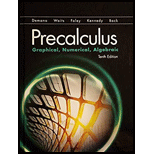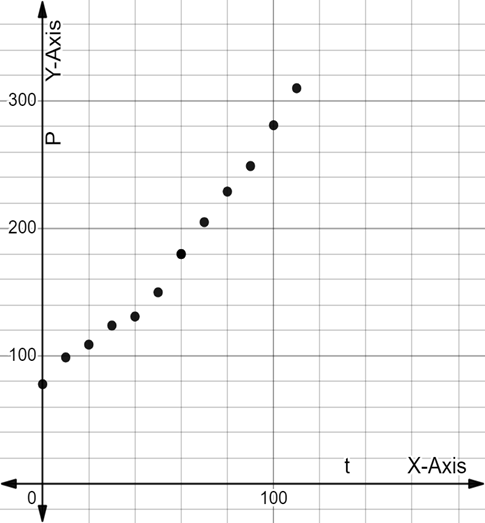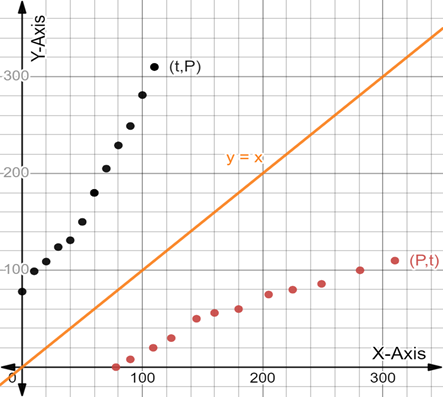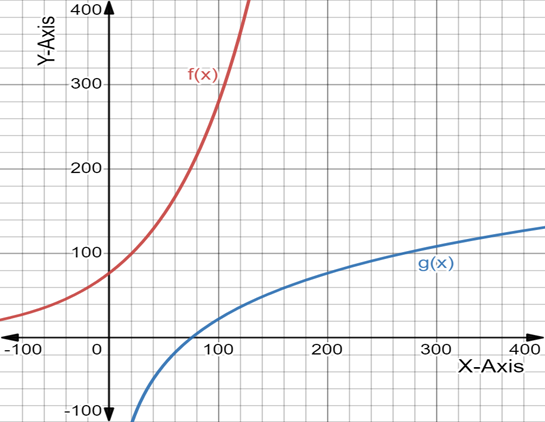
a.
To graph: Create a
Given information:
The number of years after
The U.S. population (in millions) is
| Year | Population |
Graph:
Let
By given data table:

Interpretation:
Use of the data from the specified table, obtained the scatter plot of
b.
To graph: Plot a scatter of the
Given information:
The number of years after
The U.S. population (in millions) is
| Year | Population |
Graph:

Interpretation:
Use of the data from the specified given table, Obtained the scatter plot of
c.
To graph: Show that the two plots are reflections of each other about the line
Given information:
The number of years after
The U.S. population (in millions) is
Graph:

Interpretation:
The reflection of the point
d.
To calculate: Find an exponential model
Exponential regression:
Logarithm regression:
Given information:
The number of years after
The U.S. population (in millions) is
Exponential regression:
Logarithm regression:
Concept used:
Exponential regression:
Logarithm regression:
Calculation:
To find logarithmic and exponential regression use formulas:
Exponential regression:
Logarithm regression:
Find
For Exponential regression:
Take two points
Substitute the values:
And;
Thus obtained Exponential regression:
Find
For Logarithm regression:
Take two points
Substitute the values:
Now,
Substitute the
And;
Thus obtained Logarithm regression:
Conclusion:
e.
To graph: Graph the exponential regression model.
Given information:
The number of years after
The U.S. population (in millions) is
Exponential regression:
Logarithm regression:
Graph:
Exponential regression:
Logarithm regression:

Interpretation:
Obtained the graph of functions
f.
To calculate: Analytically show how to compute the logarithmic regression value
Given information:
The number of years after
The U.S. population (in millions) is
Exponential regression:
Logarithm regression:
Formula used:
Exponential regression:
Logarithm regression:
Calculation:
For
Conclusion:
Chapter 3 Solutions
EBK PRECALCULUS:GRAPHICAL,...-NASTA ED.
- Use the information to find and compare Ay and dy. (Round your answers to four decimal places.) Function x-Value Differential of x Ду = dy = y = x² + 2 x = -4 Ax = dx = 0.01arrow_forwardCalculus lll May I please have the statements with blank lines completed; furthermore, may I please have the text box completed? Thank youarrow_forwardCalculus lll May I please have the statements completed for the following text lines and box? Thank you so much,arrow_forward
- Calculus lll May I please have the solution for the following exercise? Thank you so mucharrow_forwardCalculus lll May I please have the solution for the following exercise? Thank you so much,arrow_forwardCalculus lll May I please have the solution for the following exercise? Thank you so mucharrow_forward
- Calculus lll May I please have the solution for the following example? Thank youarrow_forwardCalculus lll May I please have the statement completed for the following box? Thank you so much,arrow_forwardCalculus lll May I please have the solution for the following exercise? Thank you so mucharrow_forward
- Use a graphing calculator to find where the curves intersect and to find the area between the curves. y=ex, y=-x²-4x a. The left point of intersection is (Type integers or decimals rounded to the nearest thousandth as needed. Type an ordered pair.)arrow_forwardFind the area between the curves. x= -5, x=3, y=2x² +9, y=0 The area between the curves is (Round to the nearest whole number as needed.)arrow_forwardcan you solve these questions with step by step with clear explaination pleasearrow_forward
 Calculus: Early TranscendentalsCalculusISBN:9781285741550Author:James StewartPublisher:Cengage Learning
Calculus: Early TranscendentalsCalculusISBN:9781285741550Author:James StewartPublisher:Cengage Learning Thomas' Calculus (14th Edition)CalculusISBN:9780134438986Author:Joel R. Hass, Christopher E. Heil, Maurice D. WeirPublisher:PEARSON
Thomas' Calculus (14th Edition)CalculusISBN:9780134438986Author:Joel R. Hass, Christopher E. Heil, Maurice D. WeirPublisher:PEARSON Calculus: Early Transcendentals (3rd Edition)CalculusISBN:9780134763644Author:William L. Briggs, Lyle Cochran, Bernard Gillett, Eric SchulzPublisher:PEARSON
Calculus: Early Transcendentals (3rd Edition)CalculusISBN:9780134763644Author:William L. Briggs, Lyle Cochran, Bernard Gillett, Eric SchulzPublisher:PEARSON Calculus: Early TranscendentalsCalculusISBN:9781319050740Author:Jon Rogawski, Colin Adams, Robert FranzosaPublisher:W. H. Freeman
Calculus: Early TranscendentalsCalculusISBN:9781319050740Author:Jon Rogawski, Colin Adams, Robert FranzosaPublisher:W. H. Freeman
 Calculus: Early Transcendental FunctionsCalculusISBN:9781337552516Author:Ron Larson, Bruce H. EdwardsPublisher:Cengage Learning
Calculus: Early Transcendental FunctionsCalculusISBN:9781337552516Author:Ron Larson, Bruce H. EdwardsPublisher:Cengage Learning





